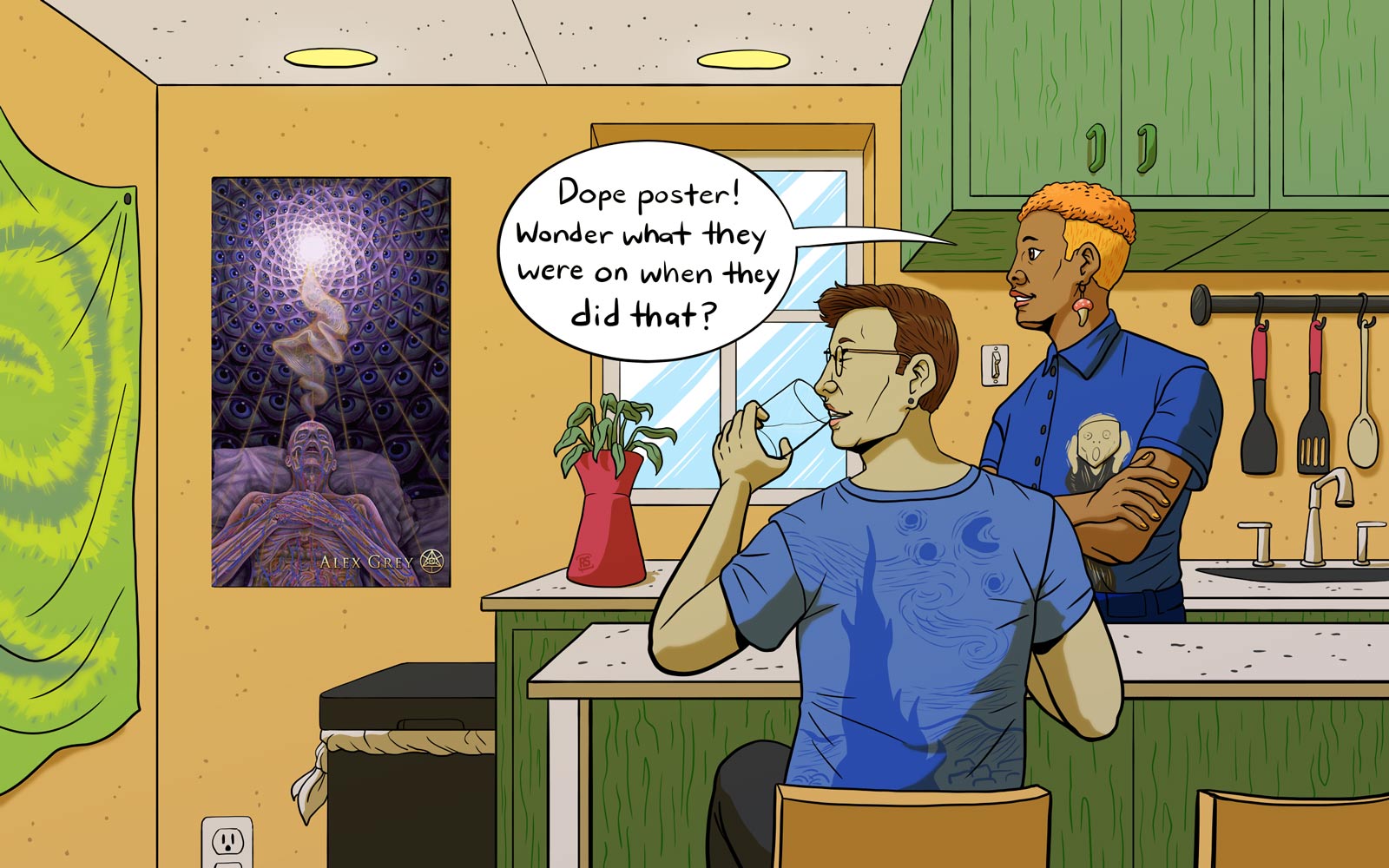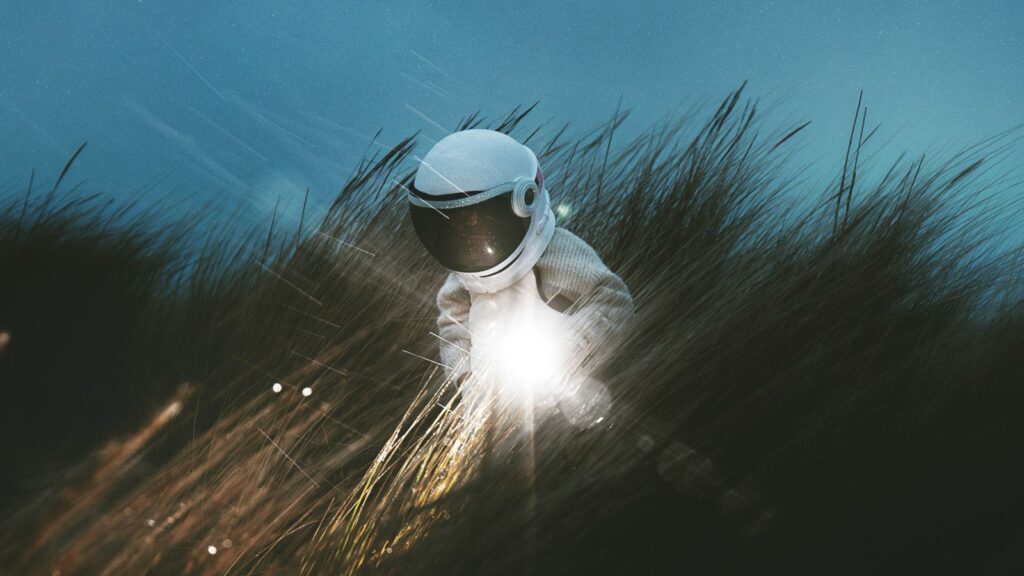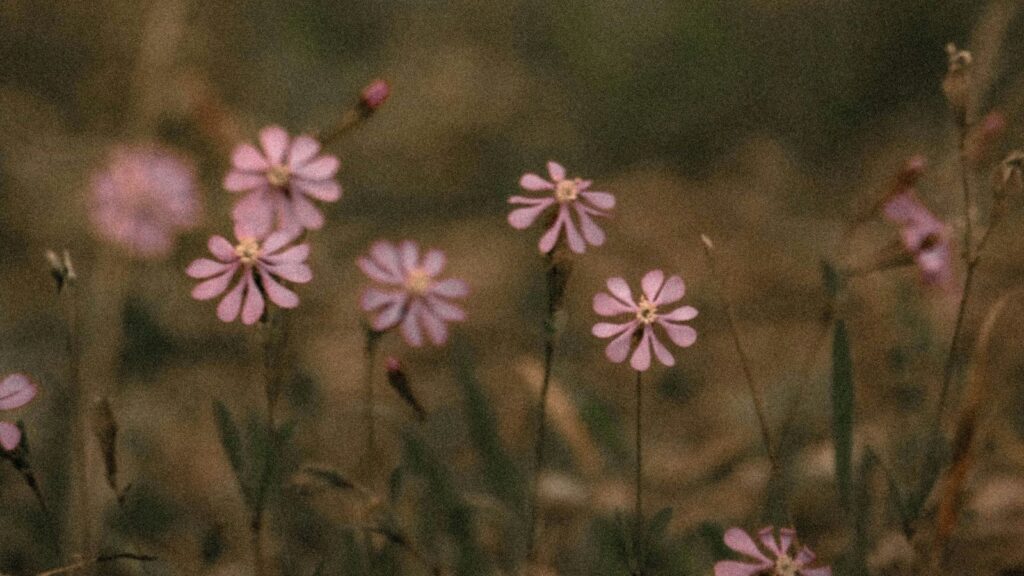Journey with us as we traverse the vivid contours of consciousness through the stunning landscapes of psychedelic art. Far from being simply an explosion of bright colors and intricate patterns, this mesmerizing art form is a window into the human psyche, a reflection of the mind-altering experiences inspired by the mystical world of hallucinogens.
Born out of the counterculture movement of the 1960s, psychedelic art has continued to captivate and inspire, its vibrant hues and symbolic language resonating deeply with those who dare to explore the unknown. Dive into the rich history of this transformative art movement, discover its pioneering figures, and learn to unravel the deeper meanings hidden within its radiant tapestry.
From the symbolic lexicon of psychedelic art to an exploration of its light and dark aspects, we will guide you through this mystic realm, mirroring the very essence of a psychedelic journey. Whether you’re a seasoned psychonaut or simply curious about the intersection of art and altered states, join us as we unlock the secrets of the psychedelic mind through the lens of visual art.
The Infinite Colors of Psychedelic Art
The inception of psychedelic art can be traced back to the heart of the 1960s. Blossoming from the seeds of a counter-cultural revolution, this art form was deeply intertwined with the use of hallucinogenic substances like LSD, and others that pushed the boundaries of perception and consciousness.
A Journey Through Time: The History of Psychedelic Art
Psychedelic art emerged as a visual language of the “flower power” generation, those who sought to break free from the shackles of conventional societal norms and explore new horizons of thought and understanding. It was a movement that rose from the desire for freedom, a quest for truth, and a deep yearning to connect with the universe in ways that were unfathomable to many.
The historical origins of psychedelic art are embedded in the vibrant subcultures of the mid-20th century. This period saw an explosion of experimental music, literature, and film, each contributing to the rich tapestry of psychedelic art.
Illuminating the Path: Key Figures in Psychedelic Art
Among the pioneers of this mesmerizing art form were visionary artists like Rick Griffon, Victor Moscoso, and Wes Wilson. Each brought a unique perspective and style to the movement, but they shared a common goal: to visually interpret and share the profound, often ineffable, experiences induced by psychedelic substances.
Rick Griffon is celebrated for his record covers and promotional posters for bands like The Grateful Dead and Journey, which feature intense colors, intricate designs, and mystic symbolism.
Victor Moscoso, trained in traditional art and design techniques, rebelled against these conventions to create psychedelic poster art that resonated with the counterculture movement’s energy and ethos. His work for bands like The Doors and The Who embodied the spirit of the psychedelic era, filled with swirling forms, electric colors, and fluid typography.
Wes Wilson, often referred to as the father of the 1960s rock concert poster, introduced innovative lettering styles and vivid, dream-like imagery to the visual lexicon of psychedelic art. His posters for concerts at the Fillmore Auditorium became iconic representations of the era.
These artists, among others, dared to traverse the uncharted realms of the mind, translating their visions into artworks that continue to inspire and resonate with audiences today. The psychedelic art movement, although peaking between 1966 and 1972, continues to influence contemporary art and culture, proving that this vibrant style is more than just a relic of the past. It is a testament to human creativity and the exploration of consciousness, which continues to be relevant and deeply compelling today.
Symbolism in Psychedelic Art: Unfurling Layers of Perception
Much like the psychedelic experience itself, the art inspired by it contains multitudes. The vibrant color palettes, complex geometric patterns, and surreal imagery are often the first elements to capture the viewer’s attention. However, upon closer inspection, a rich tapestry of symbols reveals itself, offering a deeper exploration into the human psyche and the nature of existence itself.
Sacred Geometry of Psychedelic Art
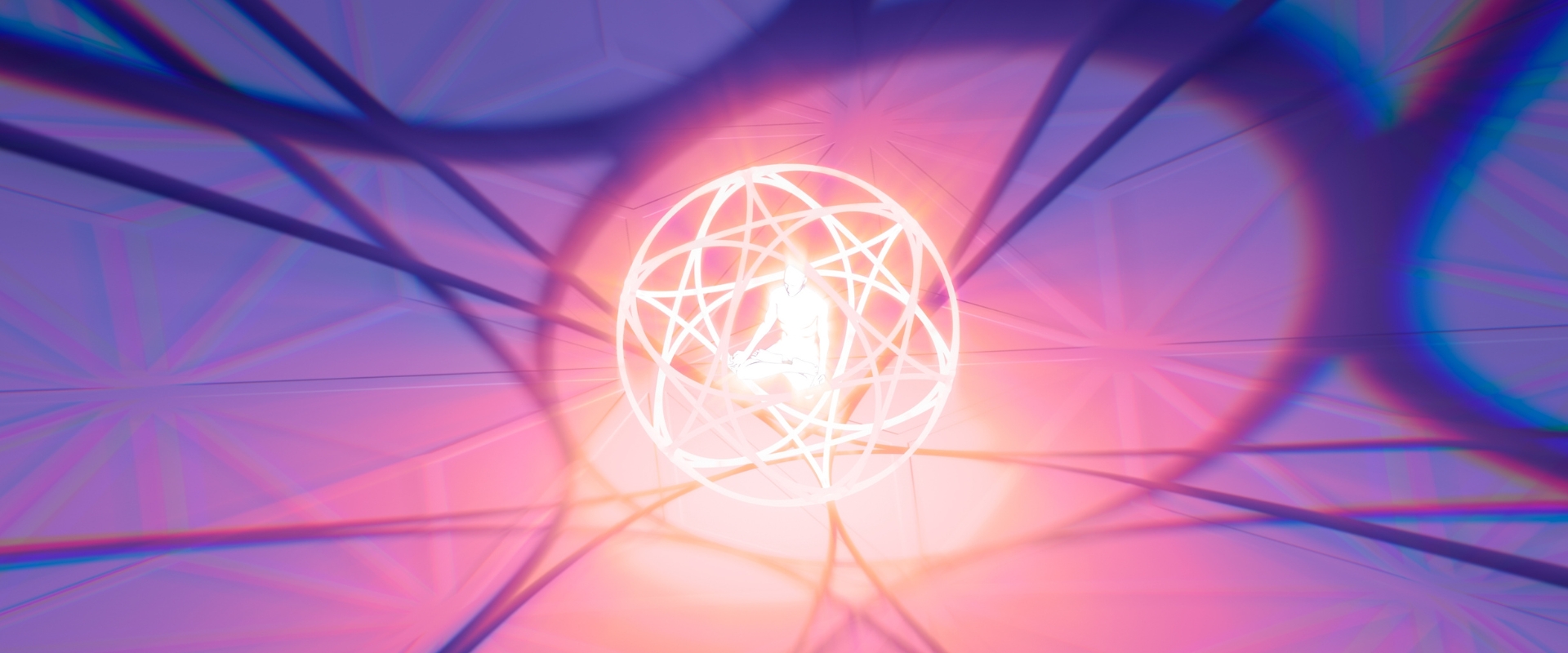
One of the most distinct elements of psychedelic art is its use of intricate geometric patterns. Often representing fractals, these patterns mirror the infinite complexity and interconnectedness of the universe. The frequent appearance of concentric circles, for instance, signifies unity, oneness, and the cyclical nature of life and death. Paisley zig-zags, another common pattern, symbolize life and vitality, embodying the undulating rhythms of the universe.
The Use of Nature and Cosmic Imagery

Psychedelic art also leans heavily into imagery drawn from the natural world and the cosmos. The proliferation of plant life, animals, celestial bodies, and other natural elements in these artworks reflect the profound sense of interconnectedness and unity with nature often experienced during a psychedelic journey.
Surrealism and Transformation
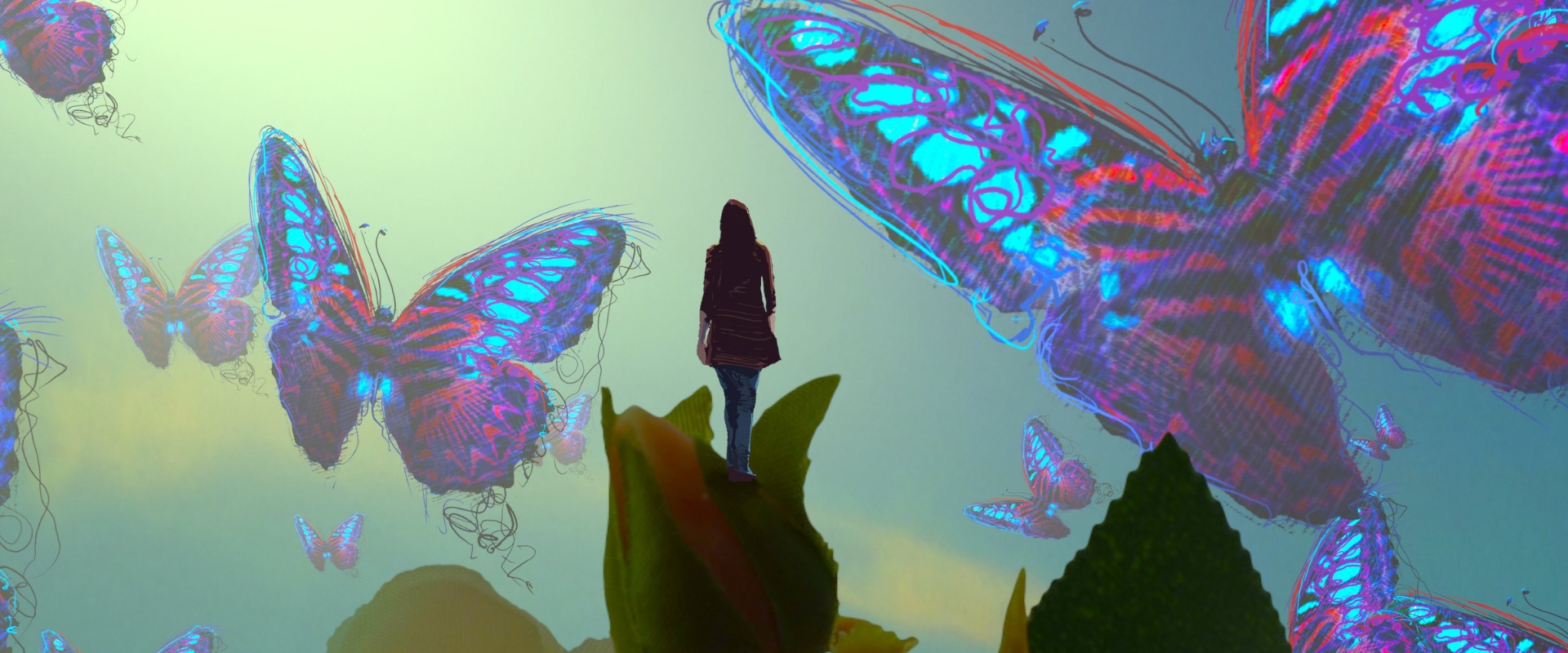
Psychedelic art often employs surreal and dreamlike imagery to capture the altered states of consciousness induced by psychedelics. Shapes morph and blend into one another, suggesting the dissolution of boundaries and the fluidity of reality. The repeated use of the butterfly, for instance, symbolizes transformation and rebirth, representing the potential for profound personal growth and evolution through the psychedelic experience.
A Portal to the Inner Self
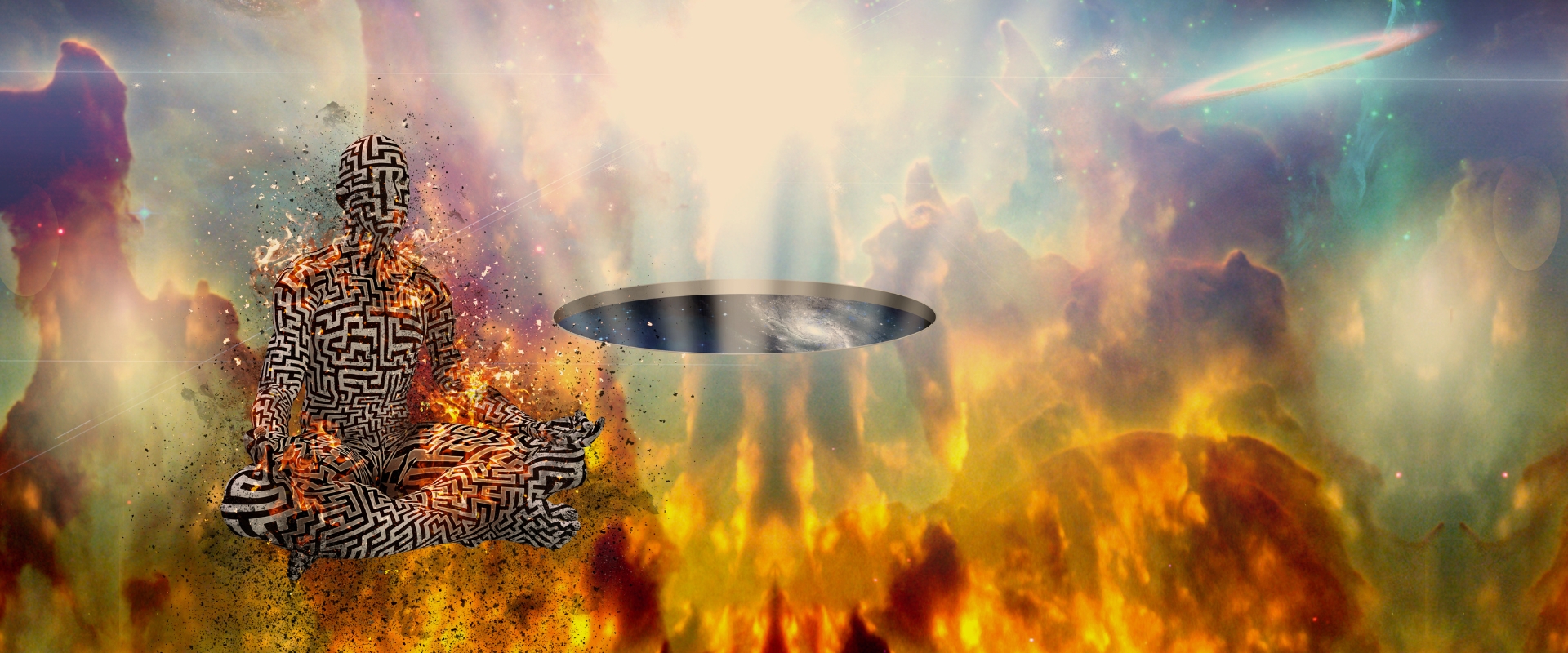
Ultimately, the symbolism in psychedelic art serves as a bridge between the tangible world and the intangible realm of the mind and spirit. It offers viewers a glimpse into the depths of human consciousness, presenting an opportunity for introspection and self-discovery. Each symbol, each color, and each swirling pattern is an invitation to embark on an internal journey – a journey that mirrors the psychedelic experience itself in its potential for profound insight and transformation.
The Shadows in the Spectrum: Exploring the Dark Side of Psychedelic Art
As with any exploration of the mind and spirit, delving into the realm of psychedelic art reveals a landscape that is not solely filled with vibrant colors and mystical light. Just as the night sky is painted with stars and cloaked in shadows, psychedelic art is a tapestry of transcendence and tribulation, ecstasy, and existential dread.
The Dual Nature of Psychedelia
Psychedelic art, like the experiences it represents, often embodies a profound duality. It expresses not only the euphoric heights of cosmic unity and spiritual enlightenment but also the more challenging aspects of psychedelic journeys. These include introspective journeys into the self, confronting fears, and reconciling with mortality — elements that can manifest as darker, even disturbing imagery within the art.
The Dark Iconography in Psychedelic Art
Among the swirls of bright colors and motifs of unity and love, darker symbols often surface in psychedelic art. Skulls and skeletons, frequently used symbols, are stark reminders of our mortality. They serve to highlight the ephemeral nature of our physical existence and prompt deep introspection about life and death.
Eyes, particularly single, omniscient eyes, also hold profound significance. Representing an all-seeing entity or universal consciousness, they reflect the sense of being observed or scrutinized, which can both comfort and unsettle.
Long hair, often associated with freedom and nonconformity, can also denote wildness, chaos, or unruly forces at play, hinting at the darker aspects of unrestrained freedom or the fear of losing control.
Unveiling the Unseen: Grotesque Visions and Healing Transitions
Hallucinogenic journeys can sometimes be emotionally overwhelming, leading to challenging or “bad trips.” These experiences can manifest in psychedelic art as grotesque visions or unsettling themes. However, such darkness doesn’t necessarily detract from the psychedelic journey’s transformative potential.
Renowned psychedelic explorer and writer Henrik Dahl noted that psychedelic journeys often contain dark elements, even during positive experiences. Confronting and navigating through these challenging passages can prove transformative and healing.
Embracing the Darkness: An Integral Part of the Psychedelic Experience
As we explore the shadowy corners of psychedelic art, it’s crucial to remember that darkness is not inherently negative. Instead, it serves as an essential counterbalance to the light, adding depth and complexity to the psychedelic narrative. Much like life itself, the psychedelic journey encompasses both light and dark, ecstasy and agony, creation and destruction. It is within this duality that the full spectrum of human experience lies, beautifully captured within the limitless bounds of psychedelic art.
Halloween Special: 5 Psychedelic Art Pieces That Haunt and Enchant
The boundless creativity and unique vision of psychedelic artists often yield pieces that are as haunting as they are beautiful, particularly resonant as we approach the season of ghosts and ghouls. Let’s take a journey through five such artworks that meld the mysterious with the mesmerizing, each crafted by remarkable artists who have significantly contributed to the psychedelic art movement.
“Dying” by Alex Grey
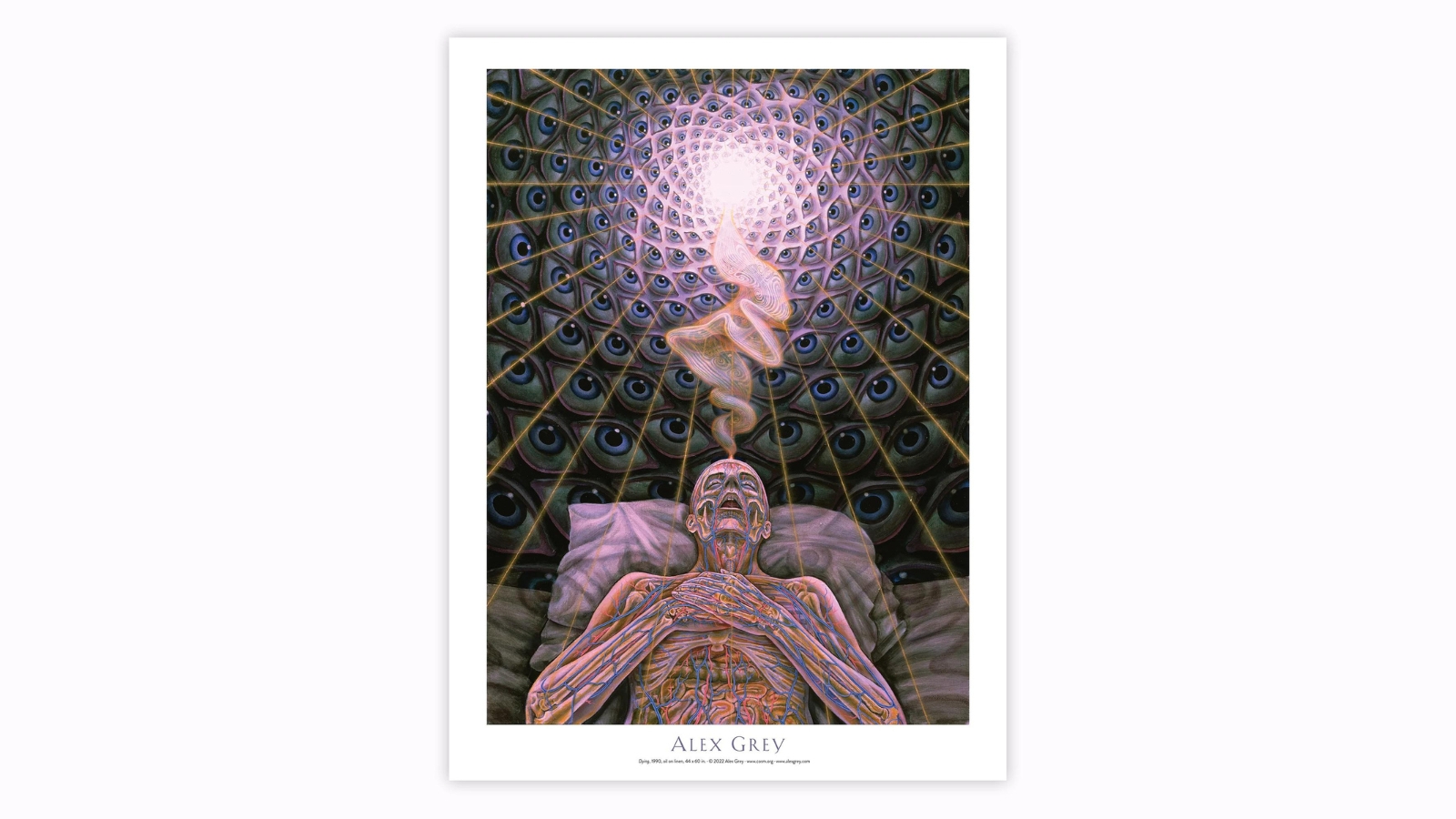
A true titan of the psychedelic art world, Alex Grey‘s works resonate with spiritual and mystical themes. His artwork “Dying” showcases the transcendence beyond physical identification, reminding us that our spiritual core persists even after bodily death.
Alex Grey’s exploration of death and the beyond in “Dying” is potent, echoing the spiritual continuity central to many ancient cultures’ beliefs. It is a deeply profound piece that feels particularly poignant as we enter the season of remembrance and reflection, reminding us of the cyclical nature of life and death.
“Jigoku Dayu/Tayu (Hell Courtesan) Tapestry” by Junko Mizuno
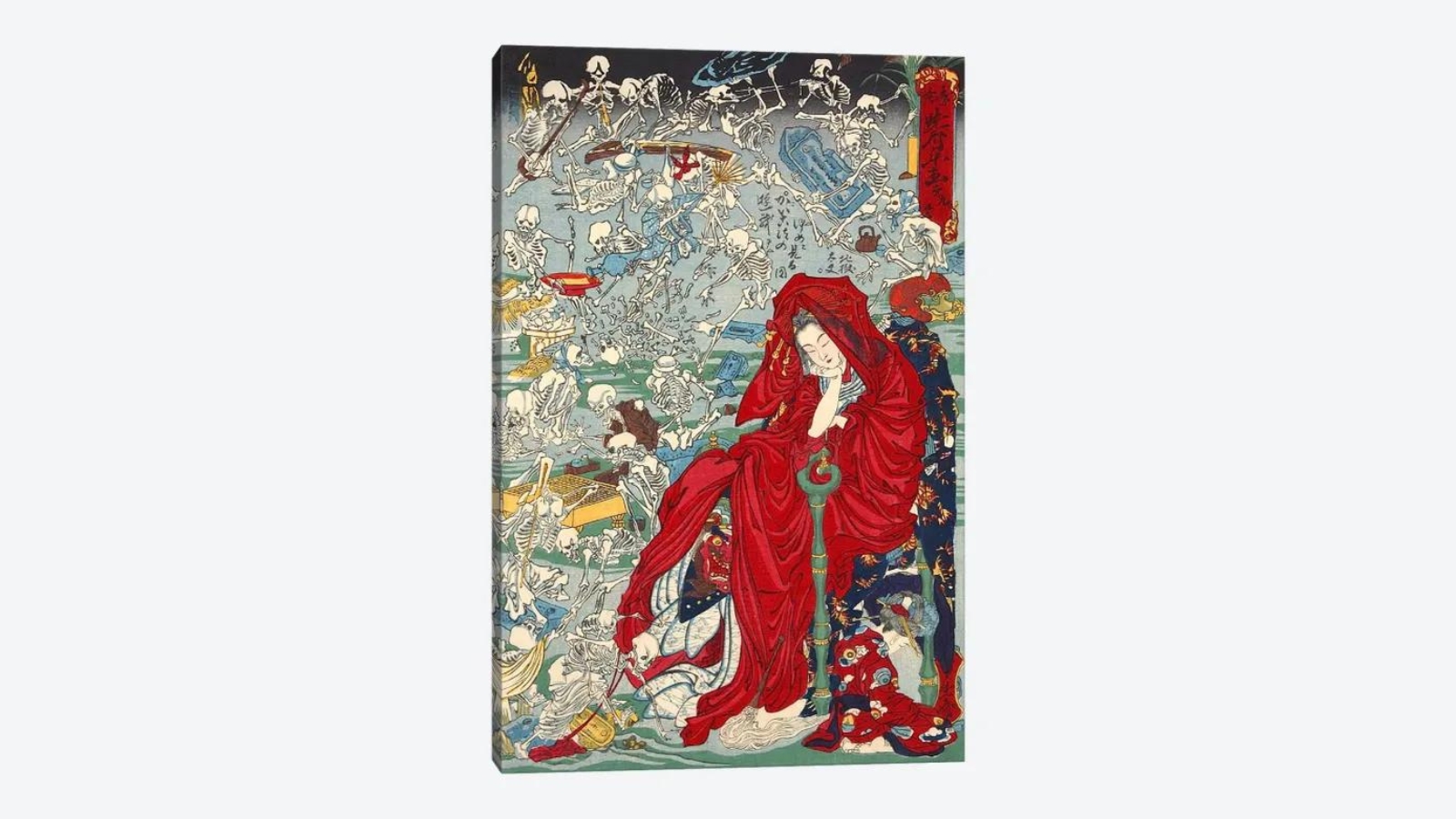
Junko Mizuno, a Japanese artist known for her distinctive style blending cute and grotesque elements, brings us the “Jigoku Dayu/Tayu (Hell Courtesan) Tapestry.” It depicts the story of a beautiful courtesan who, after enduring hardship, achieves enlightenment.
Mizuno’s mastery in juxtaposing contrasting themes is on full display in this piece. The eerie yet stunning visual narrative embodies her strength and perseverance, perfectly aligning with the season of Halloween with its motifs of suffering, transformation, and transcendence.
“Asphyxiate” by Michelle Avery Konczyk
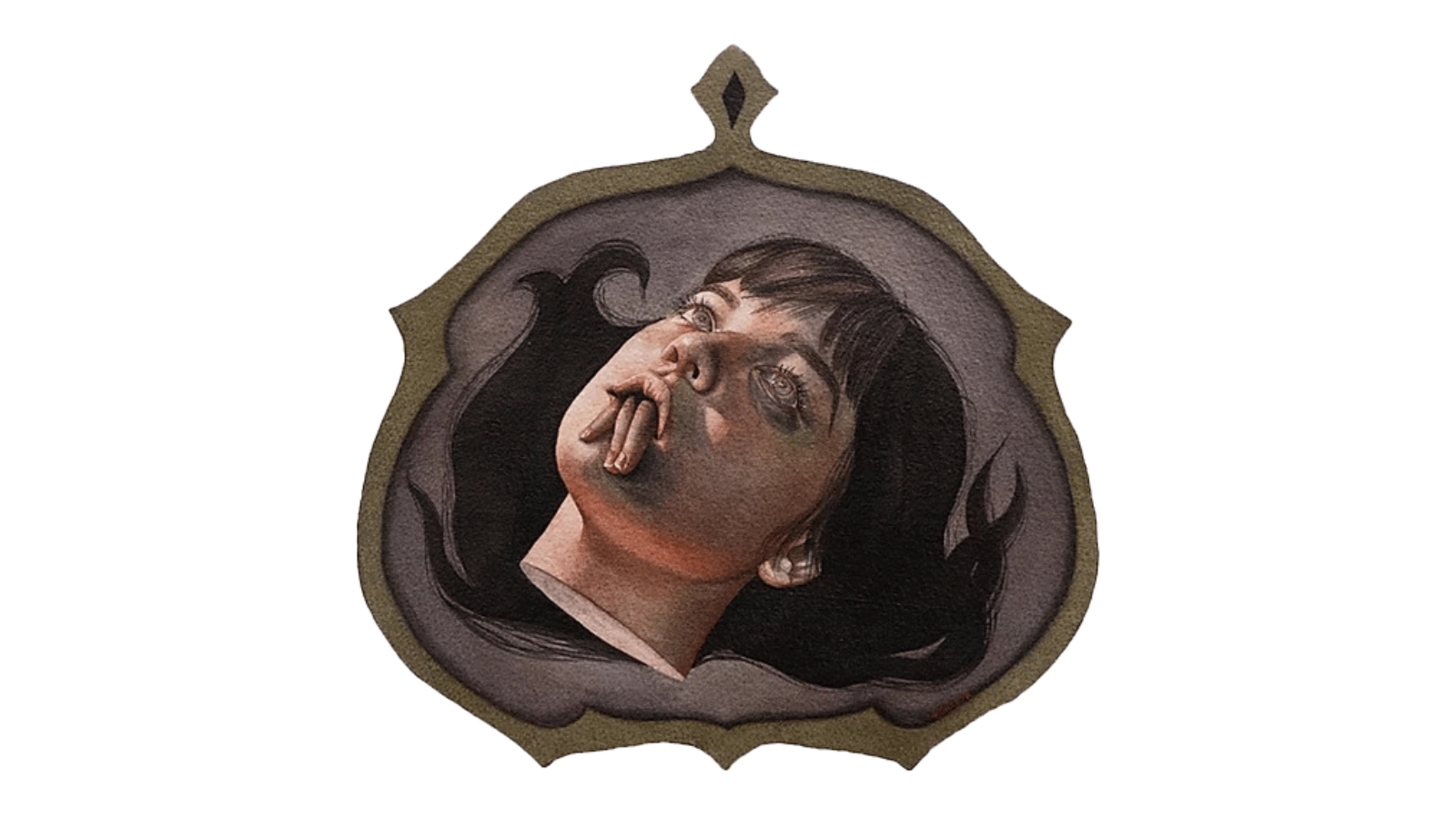
Known for her intricate watercolor paintings, Michelle Avery Konczyk‘s “Asphyxiate” is a haunting exploration of fear. Konczyk brilliantly translates the feelings of suffocation and dread into a disturbing yet captivating artwork.
“Asphyxiate” is an evocative piece that plunges viewers into the depths of their fears. Konczyk’s skillful use of black and white enhances the sense of dread, reminding us of the internal battles we face, making it an exceptionally poignant piece for the Halloween season.
“To Our Glorious Future” by Ben Ashton
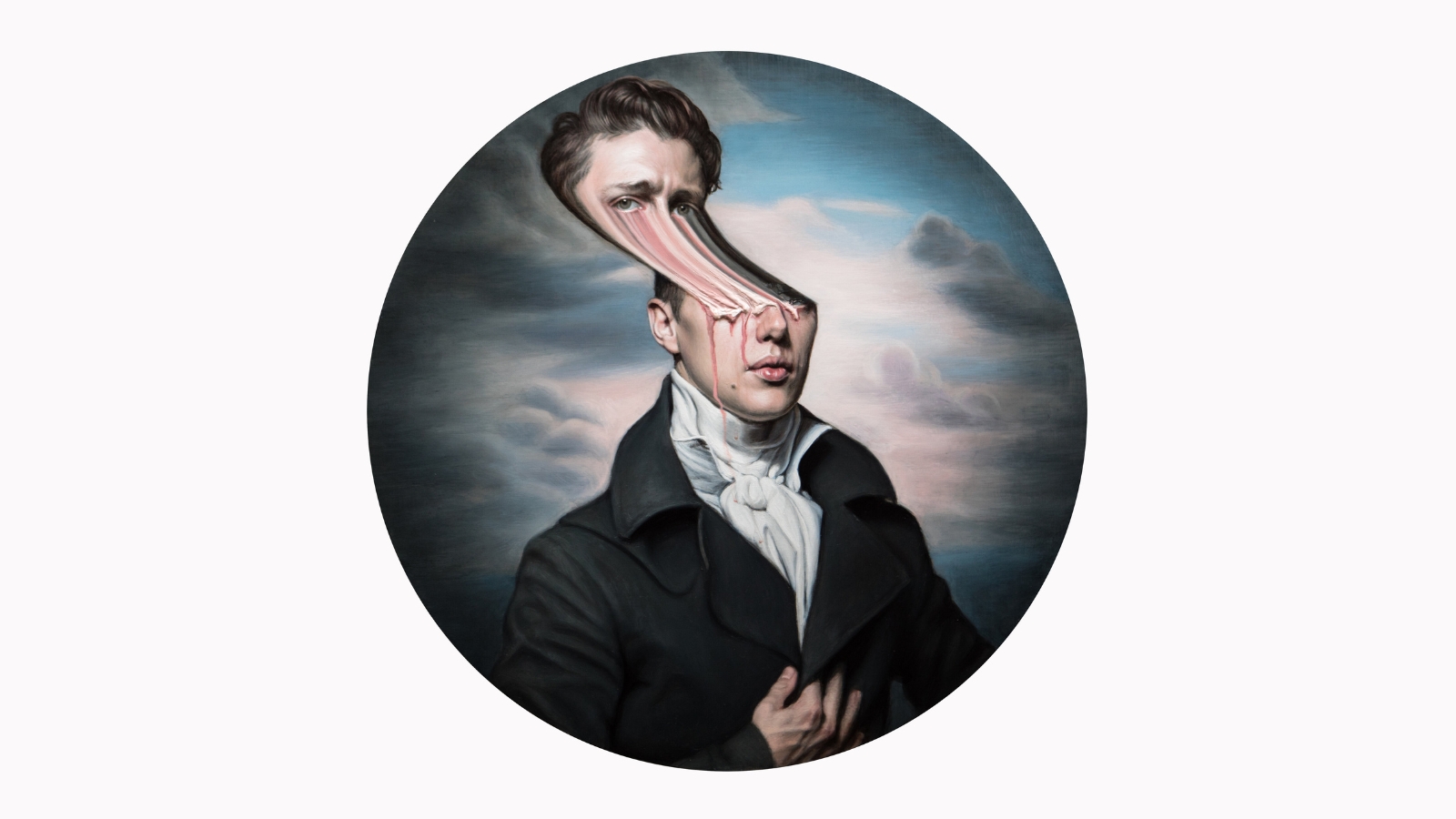
Ben Ashton, an artist known for his exploration of historical and political themes, brings us to “To Our Glorious Future.” The piece explores the idea of nostalgia and delusion in history, particularly relating to the birth of the British Empire.
In this artwork, Ashton uses psychedelic elements to disrupt confident Regency poses, symbolizing a history tainted by various misdemeanors. The haunting nature of this piece lies in its critique of past, present, and future distortions, making it a deeply contemplative work fitting for the introspective spirit of Halloween.
“The Greater Reset: Behind the Wall of Sleep” by Konstantin Bax
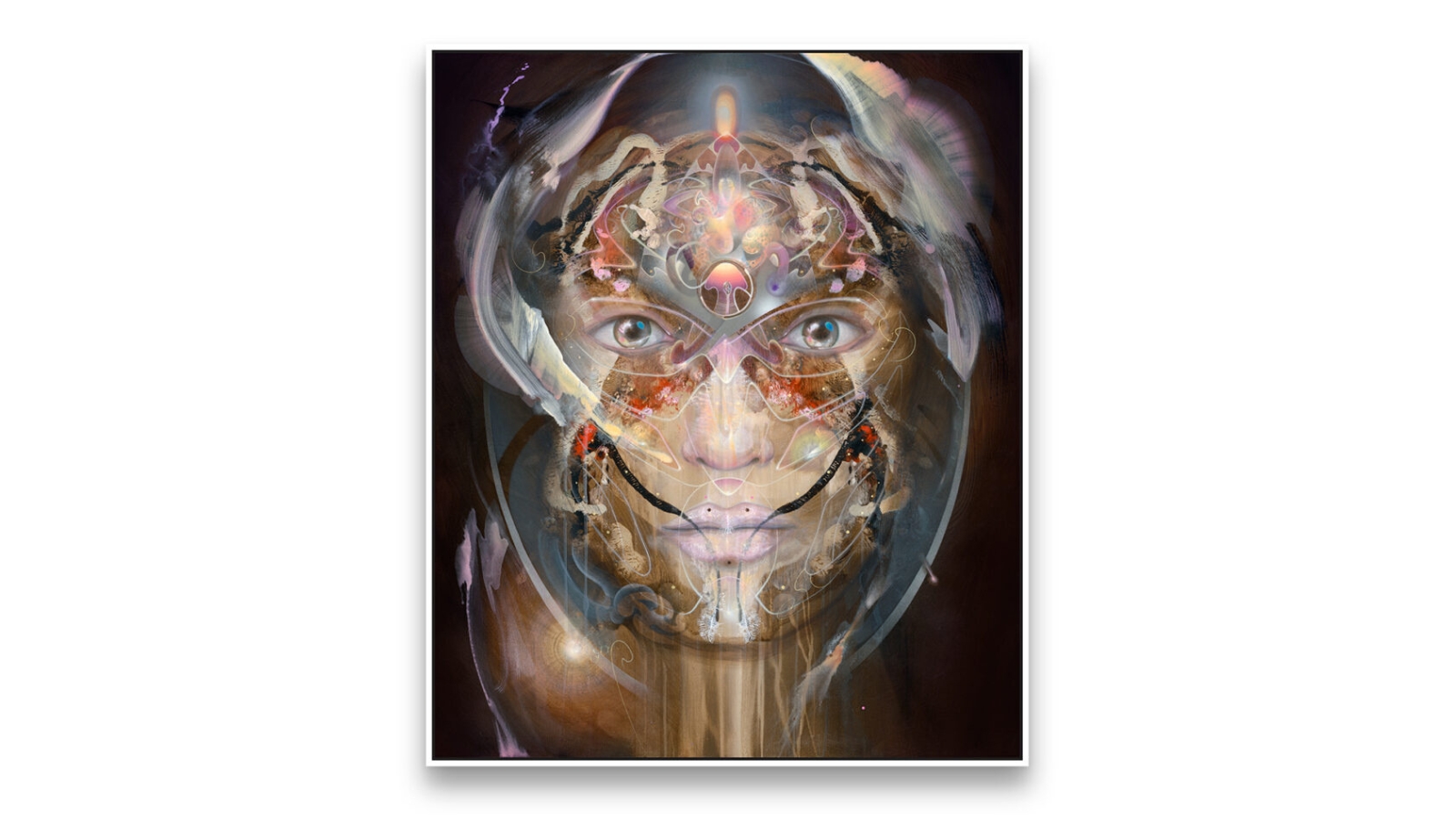
Konstantin Bax, a digital artist with a flair for creating multi-dimensional psychedelic scenes, presents us with “The Greater Reset: Behind the Wall of Sleep.” The piece draws on William Blake’s poetic sentiments of love, peace, and the divine-human form.
In this work, Bax fuses digital and psychedelic art techniques to generate a vision of humanity’s essence clothed in peace. Despite its uplifting elements, it carries an undercurrent of melancholy, making it a thought-provoking piece for the season of ghosts and shadows.
The Final Brushstroke: Embracing the Complexity of Psychedelic Art
Psychedelic art, a distinctive realm within the art universe, offers a transformative journey into the human psyche. From its pioneers in the 1960s to contemporary artists, it expresses the ineffable and magical aspects of existence. Intricate symbolism, the duality of light and darkness, and enchanting pieces beckon exploration and introspection.
As we step away from the canvas and into the world, may we carry with us the vibrant colors, the profound symbols, and the boundless spirit of psychedelic art.
